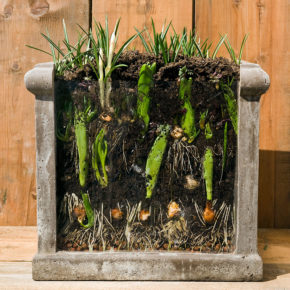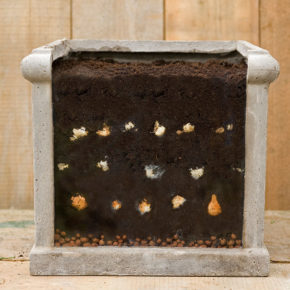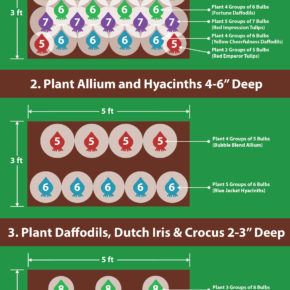Everyone wants flowers blooming all the time, right? Since I have been working with plants, I have noticed that people want flowers blooming as much and for as long as possible. I understand why people want flowers blooming all the time because flowers are beautiful! Creating a garden with flowers blooming requires planning, hard work, patience, and time.
An easy way to get a jump start on continuously blooming gardens is to layer your fall-planted bulbs for non-stop blooms. The method of layering your flower bulbs is sometimes referred to as “lasagna gardening” because you build your garden like a delicious pan of lasagna. However, instead of layering noodles, meat, sauce, and cheese, you layer lily bulbs, tulip bulbs, allium bulbs, daffodil bulbs, hyacinth bulbs, crocus bulbs and whatever else you’d like to see bloom!
Planning Your Lasagna Garden
Before you purchase your flower bulbs for your layered garden it is a good idea to come up with a plan. The first part of planning is to determine where you are going to plant your lasagna garden. How long is the area? How wide is the area? Determine the approximate square footage of the area you are planting to know how many total bulbs you will need. If you are unsure of how many bulbs to plant, Holland Bulb Farms has a handy garden area calculator you can use as a guide: https://www.hollandbulbfarms.com/garden-area-calculator
Fall planted bulbs generally do best in full to partial sun. Therefore, when choosing what bulbs to plant it is a good idea to check that they all have the same light requirements.
Coordinating colors is important in a layered garden since many of the bulbs you are planting will be blooming at the same time or will overlap bloom times with other bulbs in your garden. Determine what color scheme you would like in your layered garden.
Plan for different heights for your layered garden. The bulbs will be layered on each other in the soil based on planting depth. When you arrange them at the time of planting you will want the tallest plants in the back of the planting area, and shorter bulbs in the front.
Planting Your Lasagna Garden
One of the many benefits of layered gardening is that it will enable you to plant more bulbs in a smaller area because it allows for more space for each root system. With this planting method, you can easily attain early season, midseason, and late-season blooms all in one area or container through a little bit of planning.

You will first want to determine the bulb in your lasagna that has the deepest planting depth. For fall planting: lilies, allium, and fritillaria are larger bulbs and generally require the deepest planting depth so if you would like to plant these in your garden bed, you will want to plant those first. Backfill with soil and plant the bulbs that have the next deepest planting depth.
Tulips, daffodils, and hyacinths require at least 6” of planting depth and will most likely be the next bulbs in your layer. Backfill again with soil and add the next layer of bulbs to the planting area.
Bulbs such as dutch iris, dwarf daffodils, crocus, and certain specialty bulbs should be planted at a more shallow depth. Generally, these bulbs are planted 2-4” deep. These bulbs should be planted next in the layers. Backfill again with soil and put the last layer.
The last layer will consist of any roots or bulbs that are to be planted at a 1-2” depth. Perennials and bulbs with 1-2” planting depth are peonies, bearded iris, and bare root perennials such as daylilies, bleeding hearts, and poppies.
Layered Garden Planting Idea
Classic Spring Garden- This garden has all the classic favorites you think of when you think spring flowers. Perfect for new gardeners who don’t know where to start when it comes to planning. Covers approximately 15 square feet. ES= Early Spring | MS= Mid Spring | LS= Late Spring
- Layer 1- Plant 6-8″ deep. Space bulbs 4-6″ from each other. For a more full appearance, they can be planted in groups of 5 bulbs per group spaced 2″ apart in the grouping.(10) Red Emperor Tulips (ES) (25) Fortune Daffodils (MS) | (35) Red Impression Tulips (MS) | (35) Yellow Cheerfulness Daffodils (LS)| (20) Sky High Scarlet Tulips (LS)
- Layer 2– Plant 4-6″ deep. Space bulbs 4-6″ from each other. For a more full appearance, the bulbs can be planted in groups of 5-6 bulbs per group spaced 2″ apart in the grouping.(30) Blue Jacket Hyacinths (MS) | (20) Bubble Blend Allium Mix (LS)
- Layer 3 Plant 2-3″ deep. Space bulbs 2-3″ from each other. For a more full appearance, the bulbs can be planted in a group of 5 bulbs per group, spaced 1-2″ apart in the grouping.(50) Jetfire Daffodils (ES) | (50) Giant Mixed Crocus (ES) | (25) Dwarf Dutch Iris Mix (ES) | (25) Tall Dutch Iris
Layering your flower bulbs is an easy way to ensure you have blooms from the beginning of the season to the end of the season. If planned carefully you could even have blooms from spring until later summer by planting lilies and herbaceous perennials in the planting area. The options are endless, so get out the big spoon and start digging into some lasagna gardening!




